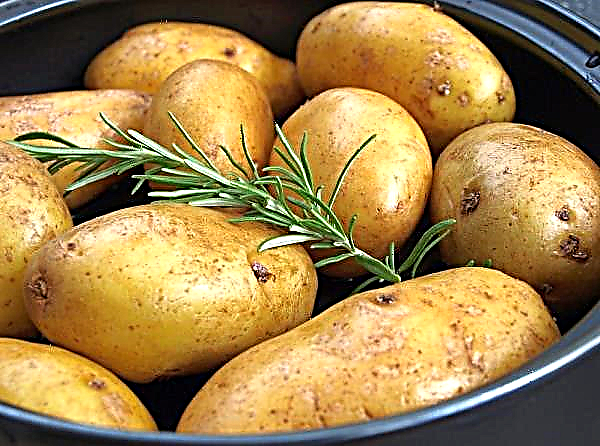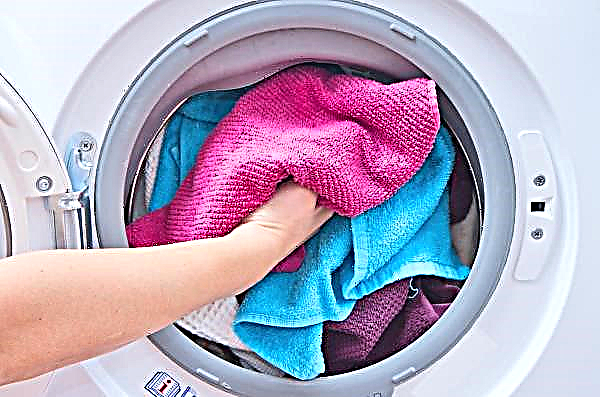Not all modern breeds of chickens are adapted to harsh climatic conditions, therefore, in regions with frosty winters, the feathered owners are faced with the issue of warming their place of residence. There are many options for implementing the plan, but before moving on to active actions, it is worth choosing the right material and familiarizing yourself with the intricacies of doing the work yourself.
Why insulate the chicken coop for the winter
The productivity of your chickens largely depends on the ambient temperature, because at low temperatures most of them stop rushing, and meat breeds are not so actively gaining weight. In addition, in the cold season, the likelihood of developing infectious and viral ailments is increased, therefore it is better to further protect the livestock from the possibility of infection (in a cold and damp room, infection occurs faster).
Did you know? Thanks to modern scientific research, it was possible to discover a very unusual, but at the same time, an interesting relationship between modern chickens and long-extinct dinosaurs. The genetic code of both species has common features, which means that the ancestors of the birds known to us once lived in the neighborhood of huge lizards.
In addition to these main reasons for insulating the chicken coop, one can also attribute the need to save feed, because when the bird is cold, it consumes more food, and the consumption of the feed mixture increases.
How to insulate a chicken shed
Any chicken coop consists of several separate parts, so it is logical to assume that when warming it, you will have to pay due attention not only to the walls, but also to the floor, ceiling, roof and even windows. How to do it right - we’ll figure it out now.
Floor
All litter for the chicken coop is conditionally divided into two types: deep and shallow, and the relevance of using each option is based on maximum temperatures in the cold season. However, most often farmers choose exactly the deep varieties, since they include several litter layers of organic material.
Important! Artificial insulation materials in this case will not work: they are not only unable to absorb bird stool, but it is also very difficult to clean after winter.
Due to the biochemical processes taking place between them, even on the coldest winter days, the temperature on the floor surface will not drop below +25 ° C, which will be quite sufficient without additional heating of the chicken coop. The ideal material for creating such a litter are:
- moss (prevents the appearance of an unpleasant odor);
- sawdust (do not allow litter to cake);
- straw (retains heat for a long time);
- hay (provides softness and, just like hay, helps maintain temperature).
 The initial thickness of such a litter should not be less than 20–25 cm, and as it sags, it is important to add 5–10 cm of new material. Moving on such a surface, birds will never freeze in their paws.
The initial thickness of such a litter should not be less than 20–25 cm, and as it sags, it is important to add 5–10 cm of new material. Moving on such a surface, birds will never freeze in their paws.Walls
Most of the heat leaves through the walls of the building, so the issue of their insulation should be given special attention. In the case when the chicken coop is made of durable material (for example, brick), it will be enough just to beat the inside of the room with foil foam, but if you want to play it safe, you can also insulate the house from the outside, using foam or foam boards for this.
Did you know? If for some reason the rooster cannot stretch its neck, then it cannot crow. Normally, the feathered voice can be heard at a distance of several kilometers from it.
The process of wall insulation is more time-consuming than organizing flooring on the floor, so it is worth considering each stage of work more carefully:
- The manufacture of wall battens. Having prepared wooden blocks (50x50 mm), the first of them needs to be nailed (or screwed) to the wall, after aligning it vertically and horizontally. After it, attach the second wooden base, departing from the first one by a width convenient for laying the selected foam sheet (with a insulation width of 60 cm, the width between the supports should be 59 cm, which will ensure a snug fit of the parts to each other).
- Installation of vapor barrier film. Its fastening is carried out using special staples of a building stapler.
- Fixation of insulation. Sheets of polystyrene foam or mineral wool should lie close to each other, and the total thickness of such a coating should not be less than 5 cm. “Mushrooms” - products consisting of a hollow leg and a wide hat, act as fasteners here.
- Close up of gaps. If there are gaps between the plates, they are closed with construction foam and the surface is leveled.
- Laying another vapor barrier (you can without it).
- Installation of plywood sheets. They perfectly close the entire insulation structure and do not spoil the appearance of the house, and given the ease of installation of the material (quickly attached with screws to the crate), you should not ignore this possibility.
 There is nothing particularly complicated in the process of wall insulation, in addition, the work plan presented is only indicative, and if any other material is available, appropriate corrections can be made to it.
There is nothing particularly complicated in the process of wall insulation, in addition, the work plan presented is only indicative, and if any other material is available, appropriate corrections can be made to it.Ceiling and roof
When arranging a barn, it is worth giving preference to rooms with an attic, because the presence of additional space will allow you to better take care of the insulation of the entire structure, and will provide a storage place for feed, bedding and work equipment. However, if there is no attic, then the ceiling can be insulated using the same materials that were used when working with walls.
In the case of arranging the roof using beams, there will be no problems with the installation of insulation, because the necessary crate is already on the horizontal surface, and you just have to fix the mineral wool or the same polystyrene in its cells. If the building has an attic, it’s still simpler: it’s enough to roll on it a roll of insulation material.
In working with horizontal surfaces, loose warming materials of natural origin are suitable: moss, straw and sawdust, which will allow you to warm the chicken coop in a short time without any material investments.
Windows and doors
Through the windows and doors of the chicken coop, the lion's share of all the heat stored inside is leaving, so the question of their insulation is no less relevant than the insulation of walls, ceiling or floor. Most often, only 1-2 windows are provided in the buildings for birds, facing south or east, and in order to save more heat in the winter and ensure effective ventilation in the summer, it is advisable to use double frames for them, which make it easy to replace glass with nets.
With the advent of cold weather between the frames, you can install a plastic film (always transparent), simply attaching it to the wooden structure with buttons or small studs. It will prevent gusts of wind and keep more heat inside the chicken house. As for the door, it is usually insulated with felt and film, and from the inside they are additionally upholstered with a thick cloth or an ordinary piece of an unnecessary carpet. This will significantly reduce the resulting drafts and will not require large material costs.
It will prevent gusts of wind and keep more heat inside the chicken house. As for the door, it is usually insulated with felt and film, and from the inside they are additionally upholstered with a thick cloth or an ordinary piece of an unnecessary carpet. This will significantly reduce the resulting drafts and will not require large material costs.
Video: insulating the chicken coop
Heating system installation
In order not to think about how to properly insulate the ceiling, walls and floor in the chicken coop, you can use inexpensive insulation materials, in addition to which to install a heating system indoors. There are many options for such a solution, and here are some of the most successful.
Potbelly stove
The easiest and at the same time affordable way of warming the house by organizing a heating system is to build a brick oven or install a ready-made stove. The latter option is even more acceptable, as it is more reliable and safe. To protect the bird from burns, you can additionally protect the potbelly stove with a brick low wall, only so that it does not interfere with the dispersion of heat in the chicken coop. Unfortunately, this solution requires the constant presence of a person (to maintain the temperature in the place of burned firewood it is always necessary to add new ones), therefore, if you cannot often enter the room, then it is better to consider other possible options for its insulation.
Unfortunately, this solution requires the constant presence of a person (to maintain the temperature in the place of burned firewood it is always necessary to add new ones), therefore, if you cannot often enter the room, then it is better to consider other possible options for its insulation.
Diesel stove
In the modern market you can find absolutely any version of such a furnace, the required power of which can be calculated based on the area of the chicken house. It is characterized by high fire safety and does not require large fuel costs (diesel fuel has always been considered a relatively affordable substance). However, like a potbelly stove, a diesel stove needs constant human attention, therefore, to maintain the temperature in the house, you will have to control the flow of the fuel mixture and timely replenish its supplies inside the stove.
However, like a potbelly stove, a diesel stove needs constant human attention, therefore, to maintain the temperature in the house, you will have to control the flow of the fuel mixture and timely replenish its supplies inside the stove.
Important! Do not store fuel cans near chickens. Vapors of diesel will not do them any good.
Electric radiator
Installing a heater or battery inside the chicken coop is an excellent solution for those who want to ensure its constant heating without much effort on their part. Of course, electrical equipment costs a little more and it is also necessary to isolate it from possible contact with birds, but in the end, you can not worry about lowering the temperature in the house during your absence. Electric radiators can have a variety of forms and shapes, so you won’t have any problems choosing the right equipment for a particular room.
Infrared lamps
The constant operation of an electric radiator may well lead to a significant consumption of electricity, therefore, to reduce material costs for its payment, some farmers install infrared lamps in the house. The efficiency of such devices reaches 98%, and the features of their design allow you to evenly distribute heat throughout the room.
The ease of installation and the durability of the use of infrared lamps themselves make this heating option the most profitable of all presented. Comparing the advantages and disadvantages of each described option will help you make the final decision in choosing a heating system for your chicken coop:
| Type of heating system | Advantages | disadvantages |
| Potbelly stove | Relatively low cost of the finished product The possibility of self-manufacturing Fuel availability Good heating possibilities Easy to install in the chicken coop | The need for a good fire safety system Regular replenishment of fuel reserves (firewood) Low practicality (many options quickly rust, burn out and require repair) |
| Diesel stove | Low fuel consumption Diesel availability Ability to install anywhere in the house | Exact calculation of the chicken coop area Constant availability of fuel stocks The cost of installing the system The need for regular monitoring |
| Electric radiator | High fire safety Possibility of high-quality heating without constant human control High heat dissipation | Increased power consumption The complexity of repair in the event of a breakdown The relatively high cost of the equipment itself |
| Infrared lamps | Regular good heat dissipation Lack of combustion products Economic consumption of electric energy Uniform heat distribution throughout the house Easy installation | The need for the constant availability of spare lamps (they can not always be bought at the nearest store) Additional material costs for electricity |












